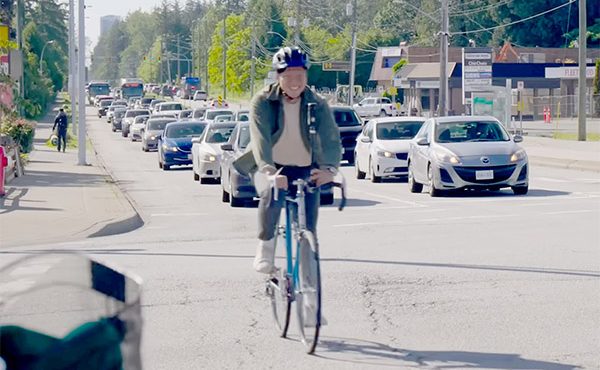 Has it been only a year since the Canada Line opened? Indeed, it was just last August that this major infrastructure project was completed, connecting downtown Vancouver with City Hall, Cambie Street, Richmond, and the Airport. It’s time to take a look back at the first year of operation.
Has it been only a year since the Canada Line opened? Indeed, it was just last August that this major infrastructure project was completed, connecting downtown Vancouver with City Hall, Cambie Street, Richmond, and the Airport. It’s time to take a look back at the first year of operation.
By John Calimente, re:place Magazine
August 17, 2009 was a day to remember: Vancouver became the first Canadian city with a rail link to its airport. BC’s largest capital project had begun construction in November, 2005, with the cost forecast to be between $1.5 and $1.7 billion. This figure would increase to $2.05 billion by the time the Line was ready, three months ahead schedule.
High ridership from day one
Encouraged by free fares on opening day, the opening drew 85,000 people from around the region who wanted to get the first ride on the $2.05 billion system. Only 50,000 had been expected. Even on the second day, when riders had to pay fares, 70,000 locals came out to ride the line. A clear trend was developing.
The Canada Line’s next big test after opening day was when direct bus routes between downtown and Richmond, Delta, and Surrey were reconfigured to turn around at Bridgeport station. September 8th saw 15,000 commuters take the Canada Line to work, up from 9,000 the previous week.
By November, the River Rock Casino at Bridgeport Station was already seeing 15,000 extra visitors per day, entering the casino building via a covered walkway from the station. River Rock also reported that the majority of their visitors were now arriving via the Canada Line.
On January 18th, a few weeks prior to the Winter Olympics, the $5 AddFare surcharge was added for trips originating at the airport. A decision was made to not charge extra either for trips to the airport or for those with prepaid tickets. Part of the reason probably lies with the fact that it would take constant enforcement to make sure everyone entering or leaving the airport paid the surcharge, especially in the absence of fare gates. Around this time the National Post reported that the Canada Line was already “operating near capacity”, though this was a large understatement given what would happen a few weeks later.
As I reported earlier, during the 17 days of the Winter Olympics in February, 3.9 million people rode the Canada Line, or an average of 228,000 per day. The Olympics also provided the opportunity for many residents to try out the line who might not have otherwise done so.
Perhaps this is one reason why ridership has not suffered post-Olympics. Automatic passenger counters installed since the first day of ridership paint a picture of increasing gains. Since April, the Canada Line has averaged 104,000 riders per day, numbers that weren’t expected to be seen until 2013 at the earliest. Average weekday boardings have steadily increased by about 1,000 to 2,000 per month, from 101,676 in April to 104,682 in May, 106,320 in June, and 107,198 in July. Overall average boardings, including weekends, are inching towards 100,000, with 94,223 in May, 97,969 in June, and 99,210 in July. For TransLink, 100,000 riders is the break-even point for operating costs, while the financial break-even point for the line as a whole could arrive as soon as 2020.
Changes due to Canada Line
Much of the ridership has come from transit users who used to take the 98 B-Line or the buses that now turn around at Canada Line stations in Richmond. Some riders have also switched from the #15 Cambie, #17 Oak, and #10 Granville routes. Prior to the introduction of the Canada Line, there were about 60,000 transit boardings per day in the corridor, with 40,000 of these on the 98 B-Line. A recent TransLink survey found that 51% of riders had previously taken the bus, suggesting that the line has won many new converts to transit. Many of these new riders are visiting the Vancouver Airport. Travel by transit to the airport is up from 3% transit mode share pre-Canada Line to 15% now. Among employees working on Sea Island, transit mode share is up 4%. As well, there are clearly a great number of residents in Richmond and along the Cambie corridor who may not have been comfortable driving or taking the bus to downtown Vancouver, but are now visiting the city more regularly because of the presence of the Canada Line.
And vice versa. Before the Canada Line I had rarely visited Richmond due to the volume of cars on the roads and the difficulty of walking in a streetscape unfriendly to pedestrians. But this has been changing very quickly as Richmond embraces a more human-scaled development in its downtown, something it has been pursuing for the past 10 years. As well, the City of North Vancouver has been densifying the area within walking distance of its SeaBus terminal, knowing that the airport is now within easy reach by rapid transit. Both municipalities are far ahead in their completion of station-area developments compared to the City of Vancouver. The Cambie Corridor planning process only began in January of this year, which means that any major developments won’t be completed for many years.
Bus riders have also benefited from the Canada Line. Many of the articulated buses that were formerly used on the 98 B-Line are now increasing capacity on the #43, 44, and #49 routes, while others have been retired. A less obvious benefit has been more frequent turnaround times on routes like the #351, which has seen a nearly 40% jump in ridership due to more frequent service and the reliability of the Canada Line when entering downtown.
It is unfortunate that Richmond currently experiences waits of 7 to 14 minutes between trains at Aberdeen, Landsdowne, and Richmond-Brighouse stations, as all of them are heavily-used destinations, especially when there is still a great deal of underutilized capacity available. Currently only 16 out of 20 trains are put into use during peak periods, reduced to 14 trains during off-peak hours. TransLink is planning to run 16 trains at all times by August 2011, which will increase frequency to about once every three minutes. And the ultimate capacity of the line is 300,000 boardings per day once a third cars is added to each 2-car train set. That’s about 15,000 passengers per hour per direction, up from the roughly 5,000 at present. The Expo and Millennium Lines together only handle about 240,000 boardings on an average weekday.
Negative impacts
Of course, not everything has gone smoothly.
The area hardest hit by the Canada Line construction hasn’t seen much of an uptick in customer traffic. While Oakridge Centre and locations close to new stations have seen 10-20% increases in foot traffic, Cambie Village has been left out, primarily because the area was not granted its own station. It is really incomprehensible that a Canada Line station was not built at 16th Avenue, since Cambie Village is the only truly complete neighbourhood along whole length of Cambie Street. In January of this year, 40 merchants filed a lawsuit against the builders of the Canada Line for the reduction in revenues caused by the ‘cut and cover’ method of construction used between Olympic Village Station and Marine Drive Station. While this method apparently saved $400 million in construction costs, the ensuing mess at street level caused businesses extreme financial hardship. $600,000 has already been awarded to Susan Heyes, who used to own a maternity clothing shop on Cambie Street. And if the merchants win their suit, expectations are that the payout will be in the range of 20 to 40 million dollars.
As well, the trolley wires that were in use along Cambie Street prior to construction were not replaced after the completion of the Canada Line. As a result, diesel buses rather than clean electric trolleys now run the #15 Cambie route, at reduced frequencies. If Vancouver is moving towards becoming a greener city, it can’t afford to be removing electric trolley routes in favour of diesel buses.
Taxi drivers were another group negatively impacted by the opening of the Line. The Vancouver Sun reported in October of last year that business was already down by 10-15% in the month that the Canada Line had been open, and probably higher in areas close to stations. Even business travellers have been foregoing the $35 cab ride to take the Canada Line to hotels in Yaletown and the downtown core. A recent report in the Province suggested that taxi drivers have now lost 30% of their business.
Limited budget
And due to budget constraints, the stations themselves have proved a major disappointment for anyone who has visited rail systems in major metropolitan areas. The stations are bare bones and small. The platforms already seem to be crowded with people most of the time. It was truly short-sighted to build 45 metre platforms instead of 100 metre platforms, especially underground. Of course longer platforms would have been more expensive, but just imagine the cost of digging up the street again to lengthen platforms in 10 or 20 years’ time. There are also too few elevators. I wish we could have learned something from the Expo and Millennium Lines and put in more than one elevator per station. If an elevator needs to go out of service, how are the elderly or the disabled expected to get out of the station? On the second day of operation, when one of the elevators at Langara-49th Avenue was not working, I helped a man with his wheelchair-bound father ride up an escalator in order to exit the station. This shouldn’t have been necessary.
More connections to existing lines would have been welcome as well. The connection between Vancouver City Centre station and Granville station is convoluted and time consuming, so much so that many people don’t know about it. Most riders will change to the Expo and Millennium Lines at Waterfront station. And this brings up the other issue – the missing link from the end of the Millennium Line to the Canada Line. While discussions on what technology will be utilized for the Broadway Line to UBC will continue for many years, it seems obvious that the Millennium Line should at least terminate with another rapid transit line. A connection to the station at City Hall would make sense, with an intermediate station at Main and Kingsway.
Moving forward
The Canada Line has shown that the Lower Mainland is ready to embrace rapid transit in a big way. With ridership easily hitting its targets ahead of schedule, there should now be little debate about whether people will ride new lines if we build them. We just need the political will and the money to start moving forward.
***
John Calimente is the president of Rail Integrated Developments. He supports great public transit, cycling, walking, transit integrated developments, and non-automobile urban life. Click here to follow TheTransitFan on Twitter.



